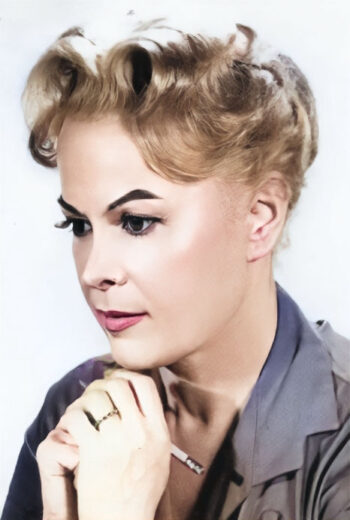Lengyel, Olga

Olga Lengyel (19 Oct. 1908 – 15 April 2001) was a Hungarian Jewess deported to Auschwitz in the spring of 1944. After the war, she wrote a book which appeared in an English translation in 1947 with the title Five Chimneys or I Survived Hitler’s Ovens, depending on the edition. In it, she claimed regarding the alleged extermination facilities and their activities, among other things:
- Before entering the gas chambers, the victims were given towels and soap (Lengyel, p. 68). This most certainly would never have happened, considering the mess it would have created and the effort necessary to retrieve and clean these items afterwards. In addition, no one takes towels into a shower.
- A cylinder of Zyklon B was released through a roof hole closed with a glass pane (ibid., p. 69). However, the current orthodox narrative has it that the content of a can of Zyklon B was poured into some Zyklon-B introduction device closed with a wooden or concrete lid.
- Babies were put into the furnaces first, “as kindling” (ibid., p. 70), as if human bodies were fuel capable of cremating one another. However, the tale of self-immolating bodies is a mere myth.
- Human fat extracted during cremation was gathered in immense casks, making her suspect that this is the reason the camp’s soap smelled peculiar (ibid.). However, fat catches fire and burns as soon as it gets in contact with fire or embers, so no fat can be extracted from a corpse on a pyre or inside a cremation furnace.
- Each of the four Birkenau crematoria had one gas chamber – although the orthodoxy insists that two of the four had two or even three such facilities (Crematoria IV & V).
- Each crematorium had one chimney – although Crematoria IV & V had two chimneys each.
- Each crematorium had “nine fires” – meaning furnaces. This number was evidently lifted from the War Refugee Board Report. In fact, Crematoria II and III had five triple-muffle furnaces, while Crematoria IV & V had one 8-muffle furnace.
- There were altogether 120 “openings” (muffles) – although there were actually (twice 5×3 and twice 8 =) 46 muffles.
- Three corpses fit into each muffle – while they were designed only for one, and could at best accommodate two, but without gaining any advantage in speed.
- 720 corpses could be cremated within an hour – while the cremation of a single corpse lasted actually an hour, hence a maximum of 46 corpses per hour could be cremated by all facilities.
- The “death pits” could destroy 8,000 bodies a day – although air photos clearly prove that those pits never existed.
From this it is clear that Lengyel took a little information from the War Refugee Board Report, but then freely invented and further inflated the cremation capacity to preposterous dimensions. From the flawed way she described the crematoria, it is clear that she had neither first-hand knowledge nor reliable hearsay information.
With regard to the number of victims, Lengyel’s figures are identical to those mentioned in a report allegedly written by an unnamed Jew deported from France (possibly Maurice Lequeux, who was with her in Lublin in early 1945), so either Lengyel copied it from there, or vice versa: the French Jew copied her figures. Either way, the numbers mentioned are obviously mendacious: 1,314,000 Jews were presumably murdered just during the period from May 1944 to late July 1944, more than the orthodoxy currently claims for the entire existence of the camp.
In her book, Lengyel was simply incorporating the usual clichés, rumors and atrocity lies that filled survivor chatter, show-trial frenzies and sensationalistic media reports of the time, spicing it up with her own inventions, exaggerations and lies.
(For details, see Mattogno 2021, pp. 385-387; Langer 2021, pp. 169-195.)

You need to be a registered user, logged into your account, and your comment must comply with our Acceptable Use Policy, for your comment to get published. (Click here to log in or register.)